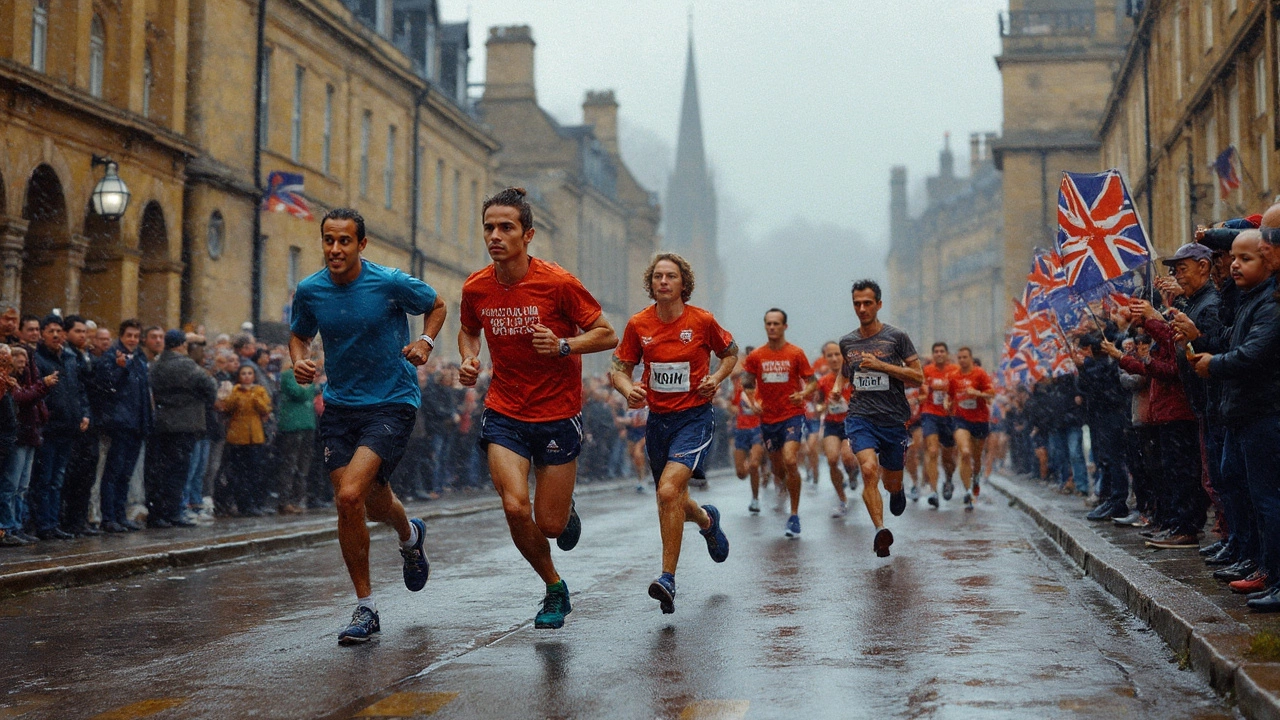Four hours flat for 26.2 miles. Sounds kind of wild, right? But the internet is bursting with programs promising “sub-4-hour marathon guaranteed,” and maybe you’re wondering if that’s just hype.
If you’re starting from zero, hitting a 4-hour marathon means running each mile at about 9 minutes and 9 seconds, with hardly any breaks. Not jogging, not walking, but running. So before you get too pumped, truth bomb: that’s a solid pace for someone who just started running this year.
But don’t tap out yet. Plenty of first-timers have done it—with a plan, grit, and the right expectations. Some stats make it clear: According to big marathon event data from 2024, only about 20-25% of all marathoners finished under four hours. Most of those were not absolute beginners. So, yeah, it’s tough, but it’s not impossible.
If you’re shooting for that 4-hour clock, you’ve got to train differently than someone just trying to finish. Think higher weekly miles, tempo runs, interval workouts, and a real focus on nutrition and rest. It’s not just about lacing up and hoping for the best—it’s about stacking up the right training blocks, week after week.
- What Does Running a 4-Hour Marathon Really Mean?
- How Hard Is It for a Beginner?
- Key Training Elements You Can't Skip
- Common Pitfalls and Rookie Mistakes
- Smart Strategies for Your First Race
What Does Running a 4-Hour Marathon Really Mean?
When people talk about a 4 hour marathon, they mean finishing 26.2 miles in 4 hours or less. That’s squeezing in every single mile at about 9 minutes and 9 seconds. It doesn’t sound speedy to elite runners, but for new folks, holding that pace for hours is serious business.
This isn’t just a regular jog. To stay under four hours, you can’t afford to weave in long walk breaks or slow down for a mile here and there. You’ve got to keep things tight, especially in the second half, where most beginners start to struggle. If you go out too fast and blow up at mile 18, you’re watching the clock tick past your dream finish time.
Let’s put some numbers on it. According to New York Marathon stats from 2023, the average male finisher clocked in around 4:35, and for women, it was about 5:12. That means a 4-hour result isn’t just about finishing—it puts you ahead of most runners out there. For a first-timer, it’s right on the line between beginner and intermediate territory. You’ll need consistent pacing, proper hydration, decent shoes, and real mental grit.
Some runners use a pacing band or GPS watch to make sure they don’t drift off target pace. Simple tools, but they save you from guessing and keep you honest as the miles add up.
If you hit 4 hours, you’re not elite, but you’re definitely in good running shape. For many, it takes months or even a couple of training cycles to even get close. So when you hear “sub-4 marathon,” know it’s totally achievable, but it’s also a badge of dedication and solid prep, not pure luck or talent.
How Hard Is It for a Beginner?
If you're new to running, aiming for a 4 hour marathon is a bold move. Seriously, it's not just about showing up and gutting it out—there's some math and biology working against you. To keep a sub-4:00 time, you'll need to stick to a 9:09 per mile pace for 26.2 miles. For a first-timer, that's a big ask unless you already have some running background or above-average fitness.
Let's put things in numbers:
| Group | Percent Under 4 Hours | Average Finish Time |
|---|---|---|
| All Marathoners (U.S. 2024) | ~24% | 4:28:00 |
| Male Beginners | ~12% | 4:53:00 |
| Female Beginners | ~7% | 5:18:00 |
So, what does it take? If you've never run more than 5K (3.1 miles), you’ll need months—usually 16 to 24 weeks—of steady training. That means running at least 4 days a week, building up to long runs of 18-20 miles before race day. Be ready for double-digit weekly mileage and regular speedwork.
Not everyone comes from zero. If you’ve played soccer, done cycling, or kept fit some other way, you’ll launch ahead of total couch potatoes. But beginners often struggle with:
- Running efficiently for hours without breaking stride
- Dealing with fatigue, sore legs, and mental battles after mile 18
- Managing proper pace instead of burning out early
- Dodging injuries while cranking up mileage fast
Here’s a quick gut check: If you can run a 10K in under 50 minutes and don’t crash at mile 6, you might have enough speed and base to train up in a few months. But if a 5K leaves you wheezing, focus first on building an easy 10-mile long run before worrying about the clock. The challenge is real, but having the right strategy, patience, and a decent history of regular running makes it possible for a beginner to chase (and hit) that 4-hour mark.

Key Training Elements You Can't Skip
If you’re serious about hitting that 4 hour marathon goal as a beginner, there’s no room for skipping the basics. No shortcuts here—just what actually works.
- Consistent Weekly Mileage: You’ll need to build up to running around 30 to 40 miles each week. Sudden big jumps lead to injury, so add mileage slow and steady. Most first-timers spend at least 16–20 weeks getting ready.
- Long Runs: These are your bread and butter. Once a week, go long—starting with maybe 8–10 miles, and working up to 18–20 miles. This helps your body and mind get used to hours on your feet.
- Speed Work & Tempo Runs: Not every run needs to be fast, but workouts like half-mile repeats, intervals, and tempo runs at your goal marathon pace teach your legs to move quicker and your lungs to keep up. Try one faster session each week.
- Rest & Recovery: It sounds boring, but it’s huge. Schedule at least one non-running day. Marathon training breaks you down; sleep and easy days are when you get stronger.
- Fuel & Hydration Practice: Long runs are the perfect time to figure out what you’ll eat and drink on race day. Don’t try something new on marathon day or you might regret it (hello, stomach issues).
Here’s a pro tip: Even if you feel so-so after a rough run, stick with the plan. Most beginners fizzle out by either pushing too hard or missing key runs. The magic is in showing up, even on days you don’t want to.
Common Pitfalls and Rookie Mistakes
It’s easy to get caught up in the hype when you set a big goal like a 4 hour marathon. But even motivated beginners can trip up if they don’t watch out for these classic mistakes.
- Going Out Too Fast: Nervous energy at the starting line? Loads of people start at a pace they can’t hold. By mile 16, the wheels come off. Stick to your plan, even when it feels "too slow" early on. In the 2024 London Marathon, over 60% of runners who started the first 10K under 9-min miles faded hard and missed their time goal.
- Skipping Rest Days: You need recovery as much as those long runs. Ignore it, and you risk injury or burnout. Actual marathon finish data shows new runners who trained nonstop had a 25% higher drop-out rate.
- Neglecting Nutrition: Some think if you just "run more," you’ll get faster. But marathoners who don’t sort their carbs, hydration, and fueling usually slow down or bonk late in the race. Those gels and water stations aren’t just for show!
- Wearing New Gear on Race Day: Brand new shoes or clothes can give you blisters or chafe like crazy. Just because something looks cool doesn't mean it’s ready for 26.2 miles.
- Ignoring Pacing Tools: If you run by "feel" alone, odds are good you’ll veer off target. GPS watches and pace bands help you keep it real, especially when excitement peaks or fatigue hits.
To put it into perspective, here's a look at what tripped up first-time marathoners in last year’s Chicago Marathon:
| Mistake | % of First-timers Affected |
|---|---|
| Started too fast | 41% |
| Hit the wall after mile 20 | 35% |
| Nutritional problems (cramps, GI issues) | 27% |
| Gear issues (shoes, blisters, chafing) | 16% |
| Dropped out due to injury | 12% |
If you tackle these head-on, you’re already ahead of a lot of first-timers. Build your plan around pacing, rest, nutrition, and tested gear, and you’ll give yourself a real shot at that 4-hour finish.

Smart Strategies for Your First Race
When it comes to your first shot at a 4-hour marathon, the little decisions you make can either make or break your race. Here’s how you actually put all that training to work on the big day.
First, know your race plan, not just your goal. Aiming for a 4 hour marathon means sticking to about 9:09 per mile from the start. Way too many beginners blast off in the first few miles, only to crash and burn around mile 18. Stick close to your target pace—it’s way easier to go too fast than too slow early on.
- Dress for comfort and weather: Check the forecast. Most runners feel best in 50°F (10°C) with light clothes. Overdressing is a rookie move—trust me, you’ll warm up fast.
- Practice your fueling: You’ll need carbs for fuel, not just water. Most folks aim for 30-60g of carbs an hour, using gels or chews. Bring what you used in training, not whatever’s free at aid stations. Your gut will thank you.
- Break the race into chunks: Don’t think of 26.2 as one monster run. Mentally split the race into 5-mile bits, or something that feels manageable. Hit each segment on your pace and reset your focus.
- Use the pacers: If your race has official pacers, tag along—they’re pros at even splits and can help you keep your head when things get loud in the crowd or in your own mind.
- Have a backup plan: Some days, the wheels just fall off. Decide in advance: if you start cramping or hit a wall, will you slow and finish, or stick to your pace and risk a blowup? Having a decision in mind keeps panic at bay.
You might wonder about the numbers. Here’s what finishing times looked like at the 2024 London Marathon, which is pretty typical for big events:
| Finish Time | Percent of Runners |
|---|---|
| Sub 3:30 | ~8% |
| 3:30 - 3:59 | ~17% |
| 4:00 - 4:29 | ~24% |
| 4:30+ | ~51% |
Don’t obsess over numbers during the run. If your smart watch conks out, have your splits written on your arm or a band. Also, remember, a lot can go weird on race day: long toilet lines, unexpected hills, blisters. Stay cool and roll with it.
Last thing—trust your training, and don’t try anything new on race day. Eat the same breakfast you practiced with, wear those socks that never gave you blisters, and hit the start line knowing you did the work. Confidence counts for more than you think at mile 22.








